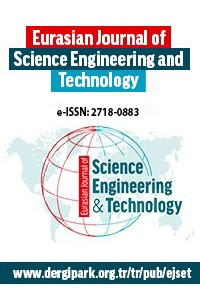Research Article
Conference Paper
Aim & Scope
The objective of EJSET is to provide an academic environment for researchers in various fields of science and engineering and for the publication and dissemination of high-quality research results in the fields of science, applied science, engineering, architecture, agricultural science and technology.
EJSET publishes original peer-reviewed Research&Review papers covering current research in all pure & applied science in the following categoryies :
- Pure Science (Biology, Biotechnology, Chemistry, Mathematics, Physics, etc…),
- Applied science (Civil Engineering, Environmental Engineering, Mining Engineering, Food Engineering, Mechanical Engineering, Electrical&Electronic Engineering, Computer Engineering, Geomatics Engineering, Mechatronics Engineering, Geological Engineering, Architecture, Agricultural Science and Technologies, etc…).
Author Guidelines
The manuscript should be prepared as
word documents in Times New Roman (font size should be 10) on A4 size. They
should be typed one and a half spaced including references and tables also. Paragraph headings should start with 0.50 cm tab indentation. Line spacing or paragraph spacing between paragraphs should not be used. Page margins should be arranged as sub-items as follows.
Bottom: 2,5cm
Right: 1,5cm
Left: 1,5cm
All figures and tables should be at appropriate place in the text. The manuscript should be in the following order:
1. Title Page:
Title: The title should be relatively short but
informative. Title should be written in font size 14, Capitalized and Bold for each
Word of the title.
Name(s) of author(s): A list of all
authors of the paper should be prepared. It will contain full first (middle)
name, full last name and should be written in font size 12. Corresponding
author should be marked with*.
Name and address of workplace(s): Authors’
affiliations should be indicated in this section in font size 8.
Personal e-mail address(es): At least one e-mail
address is needed. It will be used as the corresponding author’s email address
in all contacts with the authors.
2. Abstract:
An abstract of minimum 200 words must accompany
every article. It should be a brief summary about the significant information
of the main paper. It should be informative and present the general scope, main
results and conclusions about research/reviews.
3. Keywords:
List of all keywords proposed by the authors,
separated by commas. Provide 4-6 specific and suitable keywords related to the
manuscript. Please avoid repeating the title.
4.
Introduction/Background:
Present the subject of paper clearly, indicate
the scope of the subject, and present the goals of paper, novelty and
justification of research work and finally the organization of paper.
5.
Materials and Methods:
It should contain information about the
materials and the methods adopted to carry out the research work. The units and
dimensions should be expressed according to the metric system and SI units.
6. Results
and Discussion:
It may be combined or kept separate and may be
further divided into subsections. This section should not contain technical
details. Abbreviations and acronyms should be used sparingly and consistently.
Where they first appear in the text, they should be defined; authors may also
explain large numbers of abbreviations and acronyms in a footnote on the first
page.
7.
Conclusion:
It should be representing the summary of the
important findings and importance of results.
8.
Acknowledgments:
Acknowledgments of people, grants, funds, etc.
should be placed in a separate section before the reference list. The names of
funding organizations should be written in full.
9.
References:
References should be cited in accordance with the IEEE citation format. The references should be represented as large brackets e.g [3] in
the text. The references pattern should be in the following manner:
For Journal article
Initials Author’s Surname, Title, Journal, Volume, Issue, Page, Year.
[1] A.B. Can, B. Doruk, “Doped Graphene Synthesis and characterization,” Eurasian Journal of Science, Engineering and Technology, vol. 53, no. 2, pp. 1144-1149, 2002
For a Book
Initials Author’s Surname, Title, Edition, Place of publication, Publisher, Year.
K.S. Krane, Introductory Nuclear Physics, Third Edition, New York, Wiley, 1987.
Ethical Principles and Publication Policy
Eurasian Journal of Science Engineering and Technology (EJSET) aims to publish, share and contribute the information obtained through scientific research. Publication ethics are kept in the course of publication processes in EJSET to assure the best practice guidelines and hence it is crucial for the journal’s editors, authors, and peer reviewers to abide by the ethical policies which have been prepared on the basis of the national “Higher Education Institutions Scientific Research and Publication Ethics Directive” and the international “COPE Best Practice Guidelines for Journal Editors”, “COPE Code of Conduct and Best Practice Guidelines for Journal Editors” and “Code of Conduct for Journal Publishers”.
IMPORTANT NOTE: The similarity rate of the article to be sent to the EJSET in the literature (excluding references) should not exceed 20% for original research articles, 30% for review articles, and 5% in a single source.
Price Policy
No fee is charged for article submission, editorial processing, article processing as well as management and publishing.
